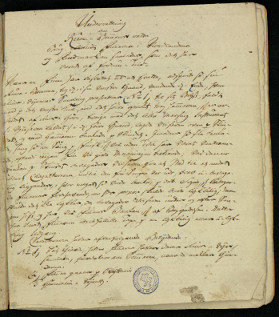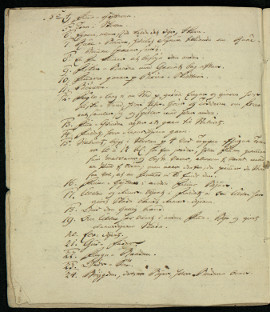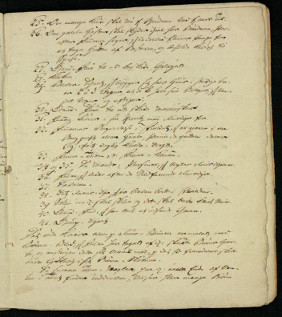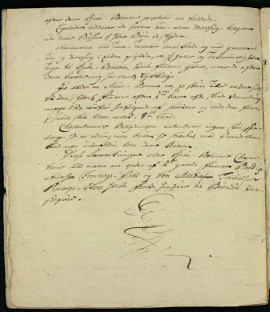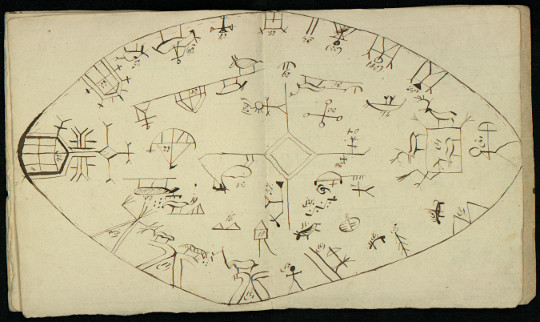Bendik Andersen Frøyningsfjell’s still extant South Sámi drum, interpreted c. 1725
Closely associated with the so-called Nærøy manuscript by Johan Randulf, vicar in Nærøy and dean in Namdalen, written when the missionary Thomas von Westen visited in 1723, is a drawing of a different drum from the one described there and an accompanying interpretation of it. Though there are some discrepancies, there can be little doubt that this drum is the one repatriated from Meininger Museen in Germany in 2023.
The drum itself is annotated with the name Bendix Andrei from Foldalen. “Bendix” must be a Latinised spelling of “Bendik”, as “Andrei” is the expected Latinisation of “Andersen”. “Foldalen” refers to the valley between the end of the Innerfolda fjord and the Lake Øyvatnet in Høylandet municipality, east of Nærøy municipality. The manuscript ascribe the interpretations to two old Sámi men, Bendik Andersen Frøyningsfjell, and Jon Torkelsen Fiplingskog. The former is clearly the same as on the drum, and thus presumably its owner. However, here he is located to a mountain in Namsskogan municipality, east of Høylandet. “Fiplingskog” must either be the region around Fiplingsvatnet lake and Fiplingsdal valley in Grane municipality north of Namsskogan, or a corruption of “Teplingsskog” (the present day area of Teplingan and Teplingdalen) which is closer, as “Tepling-Marken” and “Follingdalen” (another spelling of “Foldalen”) are mentioned together in the account of von Westens journey. All of these places are in the South Sámi area, and the drum is of classical South Sami construction and design.
The drum is reported to have been passed down for four generations, and its unusually rich embellishment with trinkets given to the drum as thanks for fortunate guidance is consistent with this. Thus the drum might very well have been a century old when it was confiscated, and can broadly be dated to the seventeenth century.
The manuscript is known as XA Qv. 23 in the Gunnerus library at the Norwegian University of Science and Technology, NTNU. It is bound with a copy of the the drawing of the drum described in the Nærøy manuscript (omitted here), and its text shares some odd word choices with that work. As von Westen’s name is wholly absent from the account, it seems reasonable to assume that it was confiscated after his missionary journeys.
The handwriting is hard to read, but the text is transcribed in Just
Qvigstad’s Kildeskrifter til den lappiske mythologi
(1903). I
have reproduced this text below with some corrections based on the high
resolution scans of the original that are now available. This text
silently expands abbreviations of the words som, paa,
den, the syllable for and geminated n and m.
The text is in Danish, but Norwegian words with no obvious Danish
counterpart are written in their Norwegian form, and in one instance
such a word is interpreted to be a Sámi word.
For clarity, I have removed the original numbering of the individual symbols from the drawing, and added modern numbers in light red in the same places. In the English translation below, I have not repeated this illustration, but replaced it with a copy of Ernst Manker’s tracing of the original drum. Here the numbering is altogether removed, as he renumbered the symbols for his own description.
Underretning
om
Rune-Bommens rette
Brug iblandt Finnerne i Nordlandene
og Findmarken saaledes, som det har
været af fordum-Tiid.
Naar en Finn har besluttet et at forrette, adspurde hand sin Rune-Bomme, tog den i sin venstre Haand, vendede den Ende, hvor Rins-Dyrenes Samling præsenteres (No. 1) til sit Bryst, faldt ned paa det venstre Knæ, med det høire oprakt, tog hammeren, som er arbeidet af Rins-Horn, tillige med det lille Messing Instrument |: Viiseren kaldet :| i den høire Haand, lagde Viiseren oven paa Skindet, og med Hammeren bankede paa Skindet. Imedens hand saa bankede, sang hand en Sang paa Finsk, som vel uden Tvil har været vantroende, efterdi ingen Fin vil give Meeningen tilkiende; ved denne banken paa Skindet bevægedes Viiseren fra et Sted til et andet iblandt Characterene, indtil den før Sangen var ude, blev u-bevegelig liggendes, i hvor meget hand vilde banke, paa det Signo, som betegnede Finnernes Forehavende, om hans propos skulde blive lykkelig; men skulde det ikke lykkes, da bevegedes Viiseren under og efter Sangen hist og her ved Finnens Banken, som af Begyndelsen. Dette har været Finnerne et infallible Tegn paa en lykkelig eller u-lykkelig Udgang.

Charactererne haver efterfølgende Betydende:
- Det Gierde, hvor Finnerne haver deres Rins-Dyr samlede, særdeles om Sommeren, naar de malker Hinderne.
- Finnen gaaer paa Skytterie.
- Hermelin-Dyret.
- Finne-Hytterne.
- Træe i Skoven.
- Egeren, eller som de kalde det Dyr, Ikorn.
- Rune-Bommen, hvilket Signum tilkiende om Rune-Bommen spaaer sandt.
- En Fin kommer at besøge den anden.
- Fisker-Baaden med Garnet bag efter.
- Finnerne gaaer paa Biørne-Skiøtterie.
- Biørnen.
- Fugle-leeg ɔ: en Sted paa grønne Enger og gierne hos Fiske-Vand, hvor Uhr-Høns og Tødderne om foraaret samler sig og spiller med hver anden.
- Finne-Quinden agter at gaae til Staburet.
- Fieldet, hvor Reensdyrene gaae.
- Staburet, bygt i Skoven paa 4 ved Toppen afhugne Træer 10 à 12 Alen høi fra jorden, hvori Finnen giemmer sine Madvarer og bedste Varer, alleene forvaret med en Pind for Døren; men naar derfra, da giemmer de Stien saa vel, at en Fremmed ei kand finde den.
- Finne-Hytter i andre Finne Byer.
- Ulven og Riins-Dyret i Fieldet ɔ: om Ulven har giort Skade blandt Reens-Dyrene.
- Gud den Hellig Aand.
- Om Ulven har været i anden Finne-Bye og giort Reensdyrene Skade.
- Els-Dyret.
- Gud-Fader.
- Færge-Baaden.
- Guds-Søn.
- Bøygden, det er Byer, hvor Bønderne boer.
- Om mange Kiør skal døe for Bønderne ved foraars Tiid.
- Om gamle Hester skal skydes ihiel hos Bønderne, hvorefter Finnerne søger, som de derved fortiener Penge for at tage Huden af Besterne, og beholde Kiødet til Spise.
- Gand-Flue til at beskade Qvæget.
- Kirken.
- Bever-Dyret, som bygger sig selv Huus i stridige Aaer 2 à 3 Etager, at de kand have sine Boliger, som vandet voxer og aftager.
- Gand-Flue til at skade Mennisker.
- Finnen kiører i sin Kirritz med Rinsdyr for.
- Finnernes Begravelse i Fieldet, som er gierne i en Bergrift eller Huule, hvorind de putter deres Liig, iført daglig Klæde-Dragt.
- Finne-Tøiten, ɔ: Finne-Konen.
- og 35. De Mands-Personer, som vogter Rinsdyrene.
- Finnen, som leder efter de Vildfarende Rinsdyr.
- Dievelen.
- Det Reens-dyr, som er bleven borte i Fieldene.
- Solen om den skal skinne og det skal blive klart Veir.
- Gand-Find, som har lært at udsende Gann.
- Goup-Dyret.
Det røde Kaars som paa Rune-Bommen er malet med Biørne-Blod, som Finnen har taget af den skudte Biørns Hierte, og anstrøgen dette sit Oracul med, paa det hand fremdeles skal blive lykkelig i sit Biørne-Skøtterie.
De smaae Tinn-Nagler, paa den anden Ende af Ovalen i Træet findes inddrevne, viiser hvor mange Biørne efter denne Rune-Bommes prophetie ere fældede.
Ligeledes inddriver de smaae Tin- eller Messing-Nagler udi deres Bøsser for hver Biørn de skyder.
Remmerne med Tinn-Traaer omviklede og med gammel Tin og Messing i Enden prydede, ere som Gaver og Taknemmeligheds Tegn til Rune-Bommen, hvilke Finnerne giver, naar de efter dens Anvisning har været lykkelige.
Jo ældre en Runebomme er, jo større Tillid er der sat til den; hvorfor Finnerne efter 2de Aars ofte skiede Anmodning neppe vilde nedføre hosfølgende af Fieldene og lade den fare, som samme skal være arved i 4de Leed.
Characterernes Betydninger aabenbarer ingen Fin, saalænge hand er ædrue; men bliver hand skiænket med Brendeviin, kand man undertiden lære deres Arcana.
Disse Anmærkninger over Rune-Bommens Characterer
med meere ere givne av 2de gamle Finner Bendix
Andersen Frennings-Field og Jon Mortensen Torchelsen
Fiplings-Skov, hvilke Fielde henhører til Brøndøe Præstegield.
Notes on the translation
In the translation, I have retained the original’s grammatical vagrancies, such as switching between the past and the present tense and other inconsistencies; and have here and there chosen an old-fashioned word or turn of phrase if it allows the translation to follow the original more closely in structure and meaning.
The text distinguishes between the prefixes “rune-” and “gand-”. The former is only used in the term “Rune-Bomme” where I render it as “magic”. The latter seems to refer to destructive magic deliberately sent out in order to harm others; I chose to use “sorcery” for this.
Notification
of
the magic drum’s true
usage among the Sámis in Nordland
and Finnmark, such as it has
been since ancient times.
When a Sámi has decided a course of action, he inquired his magic drum, took it in his left hand, turned the end where the reindeer gathering is shown (No. 1) to his chest, fell down on the left knee with the right one upright, took the hammer which is wrought of reindeer horn together with the small brass instrument called the indicator in the right hand, laid the indicator on the drumskin and beat on the skin with the hammer. While beating, he sang a song in the Sámi language, which doubtlessly has been pagan, as no Sámi will reveal its meaning; by this beating on the drumskin, the indicator moved from one place to another among the symbols, until it before the song ended remained motionless, no matter how much he was beating, on the symbol which designated the Sámi’s purpose if his proposition were to be fortunate; but should it not succeed, the indicator would keep moving under and after the song hither and thither by the Sámi’s beating, as in the beginning. This has to the Sámi been an infallible sign of a fortunate or unfortunate end.
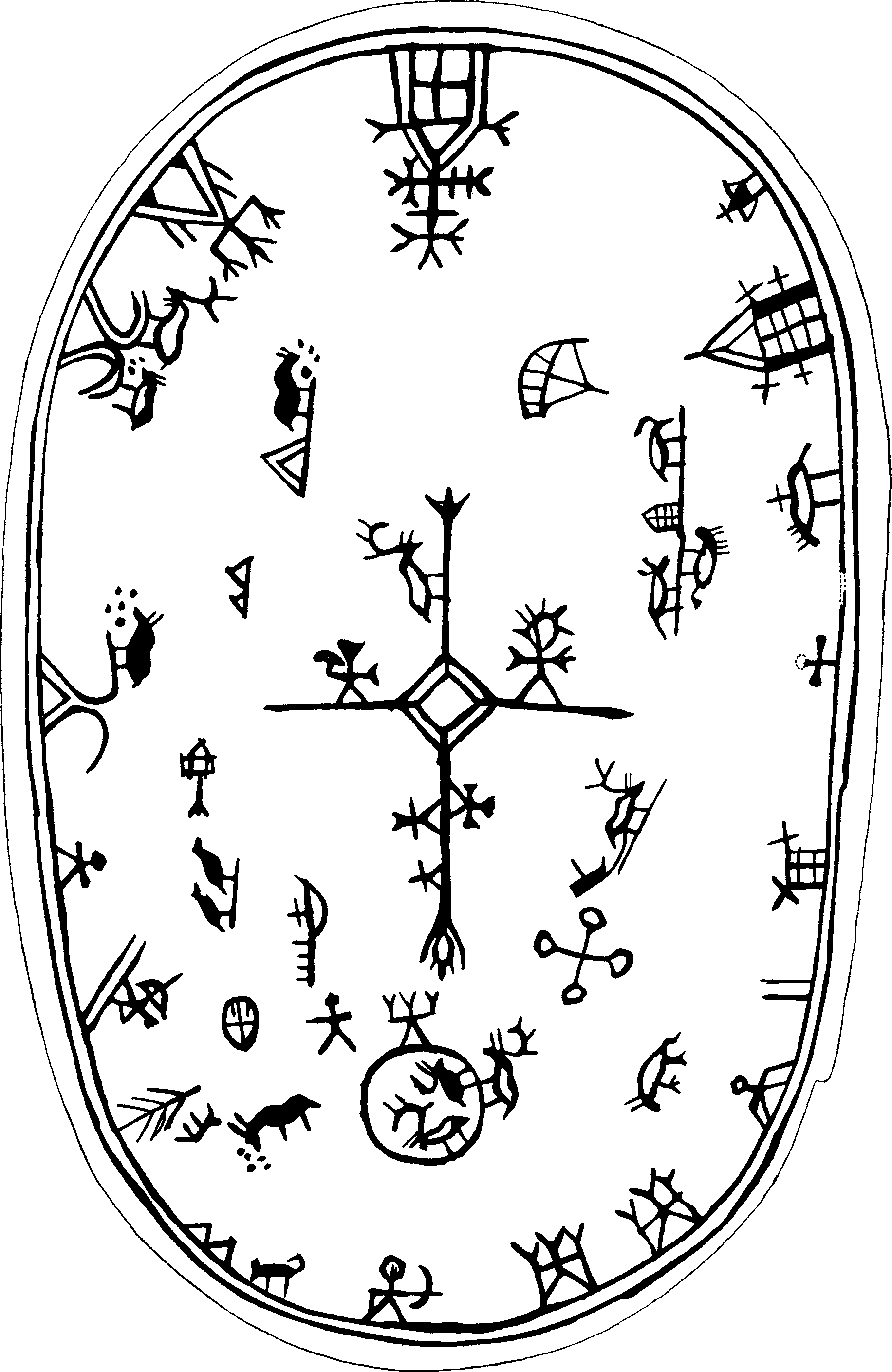
The symbols have the following meanings:
- The fence, where the Sámis keeps their reindeer gathered, especially in the summer, while milking the hinds.
- The Sámi goes shooting.
- The ermine.
- The Sámi huts.
- Trees in the forest.
- The squirrel, or as they call the animal, ikorn. [‘ikorn’ or ‘ekorn’ is actually the Norwegian word, which the author has not recognised as such]
- The magic drum, whose symbol signifies whether the drum prophecies correctly.
- A Sámi comes to visit the other.
- The fishing-boat with the net behind.
- The Sámi go bear-shooting.
- The bear.
- Bird lek, i. e. a place in green meadows, often by fishing-lakes, where black grouse and capercaillies gather in the spring, lekking with each other.
- The Sámi woman goes to the storehouse.
- The mountains, where the reindeer roam.
- The storehouse, built in the forest on four trees cut off at the tops, ten to twelve ells tall from the ground, in which the Sámi hides his provisions and best goods, solely protected by a stick across the door; but when leaving, they hide the path so well that a stranger cannot find it.
- Sámi huts in other Sámi settlements.
- The wolf and the reindeer in the mountains, i. e. whether the wolf has caused damage among the reindeer.
- God the holy ghost.
- Whether the wolf has been in other Sámi settlements and caused damage to the reindeer.
- The elk.
- God the father.
- The ferry boat.
- God the son.
- The village, that is settlements where the farmers live.
- Whether many of the farmers’ cows will die in the spring.
- Whether old horses shall be shot among the farmers, after which the Sámis seek, that they thereby earn money for removing the hide from the beasts, and keep the meat to eat.
- Sorcery-fly for harming the cattle.
- The church.
- The beaver, which builds itself houses in rapid streams two to three stories high, so that they can keep their abodes as the water rises and falls.
- Sorcery-fly for harming people.
- The Sámi drives in his sledge drawn by reindeer.
- The Sámis’ burial in the mountains, which is often in a rock cleft or a cave, wherein they place their corpse, dressed in everyday clothes.
- The Sámi wench, i. e. the Sámi wife.
- and 35. The menfolk who guard the reindeer.
- The Sámi who searches for the lost reindeer.
- The devil.
- The reindeer which is lost in the mountains.
- The sun if it will shine and the weather will be clear.
- A Sámi sorcerer, who has learnt to send out sorcery.
- The lynx.
The red cross that is painted on the drum with bear’s blood, which the Sámi has taken from the heart of the bear that has been shot and painted this his oracle with, so that he shall remain fortunate in his bear-shooting.
The small tin nails that are driven in the wood at the other end of the oval shows how many bears that have been felled after the prophecy of this drum.
Likewise, they drive small tin or brass nails into their guns for each bear they shoot.
The straps wound with tin thread and decorated by old tin and brass at the end, are gifts and tokens of gratitude which the Sámis give to the drum when they have had good fortune by its guidance.
The older a drum is, the more it is trusted; which is why the Sámis after two years of frequent requests barely would bring the accompanying one down from the mountains and let it go, as it is claimed to be passed down for four generations.
The meanings of the symbols no Sámi will reveal as long as he is sober, but if he is given strong liquor one may sometimes learn their secrets.
These annotations on the symbols of the drum and more are given by the two old Sámis Bendix Andersen Frøyningsfjell and Jon Torkelsen Fiplingskog, their surnames being mountains in Brønnøy parish.
Comments on the content
The title is deceptive, as it claims to describe the usage among the Sámis “in Nordland and Finnmark”, while its owner and his ancestors had always been living immediately to the south of the southernmost of these regions; something that must have been obvious to the author.
Like the drum annotated by Olaus Stephani Graan, this interpretation provides natural phenomena as the meaning of several symbols corresponding to ones known to represent deities in other drums. For others, they are stated to represent Christian trinity rather than the highest Sámi deities.
